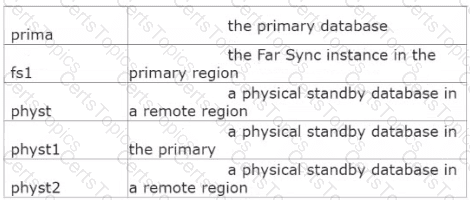Which two are prerequisites for configuring flashback database for Oracle 19c databases, in a Data Guard environment?
Which three statements are true about redo transport?
You must configure flashback database for your Oracle 19c databases that will be part of a Data Guard Broker configuration.
The databases are all in ARCHIVELOG mode.
You will execute the SQL statement:
ALTER DATABASE FLASHBACK ON;
Which three are true concerning this command?
Your Data Guard environment has two remote physical standby databases.
Client applications use the local naming method to connect to the primary database instance.
You want applications to automatically connect to the new primary database instance in case of a switchover or a failover.
Which set of actions will fulfill this requirement?
Which statement is true regarding Oracle Net connectivity for a Data Guard Broker configuration?
Examine the Data Guard configuration:
DGMGRL> show configuration;
Configuration - Animals
Protection Mode: Max Availability
Databases:
dogs - Primary database sheep
- Physical standby database cats
- Physical standby database
Fast-Start Failover: DISABLED
Configuration Status: SUCCESS
An attempt to enable fast-start failover raises an error:
DGMGRL> enable fast_start failover;
Error: ORA-16693: requirements not met for enabling fast-start failover
Failed.
Identify three possible reasons for this error.
Which three statements are true about Data Guard database modes and states?
Which TWO statements are true regarding Data Guard Broker?
A Data Guard environment has this configuration and these attributes:
A primary database
A physical standby database named sbdb
The configuration is in maximum availability protection mode.
Then sbdb is converted to a snapshot standby database.
Which two statements are true?
Your Data Guard environment consists of these components and settings:
1. A primary database
2. Two remote physical standby databases
3. The redo transport mode is set to sync
4. Real-time query is enabled for both standby databases
5. The DB_BLOCK_CHECKING parameter is set to TRUE on both standby databases
You notice an increase in redo apply lag time on both standby databases.
Which two would you recommend to reduce the redo apply lag on the standby databases?
You are using Data Guard in conjunction with Global Database Services.
You have a Data Guard Broker configuration called Sales and a GDS pool called Prod.
Which three are true concerning the management of the broker configuration when using GDS?
On your logical standby database, you specified these rules:

After completion of the weekend batch cycle you attempt to delete the SQL Apply filters:

Which is TRUE regarding the execution of the UNSKIP procedure?
Examine the Data Guard configuration after an accidental switchover to Sheep:
DGMGRL> show configuration;
Configuration - Animals
Protection Mode: MaxAvailability
Databases:
sheep - Primary database
dogs - Logical standby database
cats - Physical standby database (disabled)
ORA-16795: the standby database needs to be re-created
Fast-Start Failover: DISABLED
Configuration Status:
SUCCESS
Which three statements will be true after a switchover to Dogs?
A customer asks you to propose the most appropriate solution for this set of requirements:
We need a disaster recovery solution that enables us to fail over from our production database with zero data loss.
We want to generate reports from the proposed standby database at the same time that it is used for data protection.
Developers may need to test occasionally on a copy of the live database
Which TWO solutions would you recommend?
Which four requirements can be met by deploying a logical standby database?
Which three are true regarding prerequisites for a logical standby database as a disaster recovery solution?
Which two statements are true when using non-rolling release upgrades in a Data Guard environment?
A customer has these requirements for their proposed Data Guard implementation:
1. Zero data loss must still be guaranteed through the loss of any one configuration component.
2. The primary database must be protected against a regional disaster.
3. Performance overheads on the primary should be minimized as much as possible given these requirements.
4. Downtime on the primary database for any reason must be kept to a minimum.
Components referred to in the broker commands are:

A)

B)

C)

D)

Which two are true about the use of RMAN recovery catalogs when offloading backups to a physical standby database?
Which THREE steps are prerequisites for the creation of a physical standby database on a separate server using the RMAN active database duplication method?
Which TWO statements are true for Data Guard environments with multi-tenant databases?
Your Data Guard environment has two remote physical standby databases.
Client applications use the local naming method to define connectivity to the primary database instance.
Which will automatically redirect clients to the new primary database in case of a switchover or failover?
Which FOUR database parameters might be affected by or influence the creation of standby databases?
Which three statements are true……. With no Oracle Streams or Goldengate configured?
You are planning to perform block comparison using the dbms comp package:

Which TWO statements are true?
Which two statements are true regarding asynchronous redo transport in a Data Guard
Which three are true about using Flashback database through role transitions in a Data Guard environment?
Examine this validate command:
DGMGRL> VALIDATE DATABASE VERBOSE "
Which THREE statements are TRUE?
You are licensed to use Oracle Active Data Guard.
Which TWO statements are true after enabling block change tracking on a physical standby database?
Which three are prerequisites for enabling Fast-Start Failover?
Examine the Data Guard configuration:
DGMGRL> show configuration;
Configuration - Animals
Protection Mode: MaxAvailability
Databases:
dogs - Primary database
sheep - Snapshot standby database
cats - Physical standby database
Fast-Start Failover: DISABLED
Configuration Status:
SUCCESS
You receive an error while attempting to raise the protection mode to Maximum Protection:
DGMGRL> edit configuration set protection mode as maxprotection;
Error: ORA-16627: operation disallowed since no standby databases would remain to support protection mode
Failed.
Which is the minimum statement, or sequence of statements you must execute to enable successful raising of the protection mode to Maximum Protection?